Ken Lizzi's Blog
October 5, 2025
The Queens of Land and Sea. Perpetual Cliffhanger.
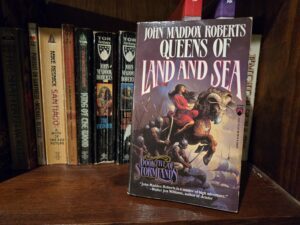
The Queens of Land and Sea is the fifth — and, unfortunately, final — volume of John Maddox Roberts The Stormlands series. While one of the early chapters adds a trifle to the travelogue of Roberts’ distant future Earth, this book offers a great deal less world building than the previous four. It does open up the possibility of future exploration by revealing a South American civilization, one possessed of naval technology exceeding that of North America — and also one bringing a contagion to which most of the North American’s do not possess a natural immunity, with calamitous consequences.
Again Ansa is the protagonist, saying farewell to his younger brother early on, and traveling to request the aid of Queen Shazad of Neva in the struggle against Mezpa. However, Queen Shazad is involved in her own troubles against a renascent Gasam and Larissa. The plot reset button has been pushed. Ansa throws himself into the struggle. The book, as expected, provides some top notch action scenes.
The — rather shocking — end establishes another reset of sorts, setting the stage for another, long-promised showdown between Hael and Gassam, likely as a culminatin of multi-sided wars between and among the Islanders, Neva, Hael’s prairie kingdom, Mezpa, and — perhaps — the South Americans. Alas, we will never know. Queens was the last book of the series published. Presumably sales did not justify another. And sadly, book four was the last appearance of Hael. He spends the entirety of this one off-stage, convalescing.
On the positive side, Roberts provided five excellent novels of high adventure. And the reader is free to imagine his own ending. I’ve actually spent some time considering a variety of scenarios and satisfactory outcomes. On the negative side, we readers are left with an unending cliff-hanger. Unless there is an outline somewhere, describing the events of future volumes, we will never know what Roberts intended. (If someone is aware of such a document, please let me know.) But that’s the risk with series fiction, and I don’t regret taking that gamble with The Stormlands. The enjoyment I received from what was published is greater than the disappointment resulting from what wasn’t.
If you’re interested in picking up a completed series, you can get my Falchion’s Company series, all three books of which are available in print, digital, or audio. (And I’ll have a bit of Falchion’s Company related news later this month.)
September 28, 2025
Yet More JMR

I appear to be in the midst of a John Maddox Roberts phase. This wasn’t intentional. I simply got caught up in the Stormlands series. Then, during a trip back to Portland and the obligatory visit to Powell’s Books, I picked up the second of his S.P.Q.R. novels. Not wanting to start with book two, I bought the first. Now, I’ve just finished the third. And this week I’m beginning the fifth, and final, volume of Stormlands. Yesterday, during a trip to the used bookstore, I happened to find the fourth S.P.Q.R. novel while the HA was finding something for herself.
I have other JMR books on my shelf. King of the Wood is a terrific alternate history adventure novel. And I have one of The Falcon novels, which he wrote as Mark Ramsay, part of a series of men’s historical adventures. So I just want to take a moment to acknowledge JMR as a prolific and talented writer of adventure stories. If you haven’t given his stuff a try, you might consider it.
You might also consider something of mine while you’re out shopping for JMR books.
September 21, 2025
The Steel Kings: Stormlands Book Four.
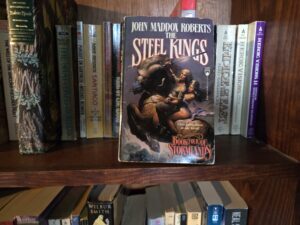
The Steel Kings. Cool title, and, not to bury the lede, a cool story.
Book four begins almost as a book end to book three. This time Kairn, Hael’s second son is the protagonist, going on an adventure, meeting a woman. The travelogue continues, the exploration of John Maddox Robert’s post-apocalyptic North America, this time presenting the Mississippi River and environs. But the narrative soon get intercut with sections dealing with Hael himself, on his mission to gain information regarding the powerful republic beyond the Mississippi, Mezpa. And since Kairn’s mission is to find Hael, the two narratives eventually converge, bringing us to the end of the first half of the novel.
The next half takes into grand, geo-political maneuvering, involving Hael, Deathmoon (the ruler of Mezpa), Larissa and Gassam, and Queen Shazad of Neva. Wars and alliances are planned. Great strategies proposed, and a campaign is begun. We get battles, upsetting of plans, and stunning reversals. It is good stuff, especially since Roberts does necessarily not take the story in the direction the reader might expect. And it ends on a cliffhanger, with hints of what might take place next. But you never know. I am looking forward to book five. (Come on, Thriftbooks, what’s taking so long?)
If you are in-between reads, how about something of mine? Give the Semi-Autos and Sorcery series a try.
September 14, 2025
Sword-and-Sorcery and Song and Dance: Steven Brust’s “Lyorn.”
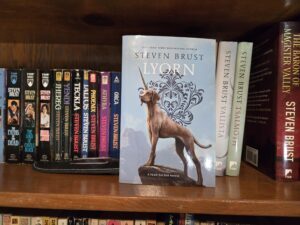
Lyorn is the seventeenth installment in Steven Brust’s Vlad Taltos series. For some reason I’d believed this would the final book, as there are seventeen houses in the Cycle of his fictional universe, and one book title now corresponds to each individual house. I was, apparently, incorrect, as this novel does not tie up loose ends. Instead it ramps up the stakes and raises more mysteries surrounding Vlad Taltos and his place in the greater scheme.
This grand scope does not help in classifying the series as S&S. While it arguably began that way, with Vlad as a street level crime boss, as the story has progressed with more and more pieces placed on the board, and the backstory reaching back into the mists of a science-fictional antiquity, the series has inched its way into epic fantasy territory. And as it increased in scope, it also decreased in action, a fundamental component of S&S.
But damn it, I could’t ignore titling this blog post entry as I did. Because Lyorn is set in a theater, specifically one in rehearsals to put on a musical. As usual with the last several Vlad Taltos books, Brust takes his theme and runs with it, incorporating it in the narrative up to and including metafictional levels. Here we get chapter entries consisting of song parodies, from Gilbert and Sullivan to Broadway musicals. The lyrics are all clever and entertaining, though I experienced an extra level of enjoyment when reading those I recognized. That was hit-and-miss, I acknowledge a dearth of knowledge of musicals. (Here is a cheat sheet, that I wished I’d encountered earlier, though it wouldn’t have helped me with all them.)
Lyorn is not a welcoming entry to the series. If you haven’t read any of them, I don’t recommend starting with book 17. But if you’ve read previous entries, you know what you’re going to get.
In Lyorn, Brust works in a historical world-building element, as the play is a revival of a once banned production. It was banned during the Lyorn cycle. Lyorn’s represent tradition and duty/honor, a sort of quasi-Samurai house. The conflicts involved in differing views regarding what duty consists of runs as a theme throughout the story. Most of the tale occurs within a theater, where Vlad is in hiding from a sorceress who wants him dead, and is putting together a plan to deal with this as well as a few other related problems, tying it all up at the end during the premiere of the show. There isn’t much action. Most of the reader’s enjoyment derives from Taltos’ inner monologue and his banter with others. Brust is, as always, a clever writer. He clearly enjoys playing games with his writing, setting himself a challenge, and creating puzzle-box narratives. Therein lies the potential weakness: readers who want to get on with the story might not appreciate what he is doing. Happily, I’ve long bought into the first-person smart-ass story telling style (cf Roger Zelazny and Glen Cook) so I’m here for it, as I have since the early 1980s when the first book in the series was published.
How much more of it there will be, I don’t know. But I’ll be waiting.

Speaking of waiting, there will be a bit of a wait for the next books by yours truly. But they are in the pipeline. Cesar the Bravo should be available for purchase from Cirsova by the general public within a couple of months. If you’ve already received a copy, please drop a review somewhere. Somewhat further down the calendar, Raconteur Press has announced a three-book series of mine, due for publication over the course of 2026. (With respect to the video announcement, and for what it is worth, my Americanized last name is pronounced “Lit-zee”, with the stress on the first syllable. One does not, for example, pronounce “pizza” as “pizz-uh” but rather as “Pete-zah.” Not that it matters. I’ll answer to most anything.)
September 7, 2025
L. Sprague de Camp’s “The Glory That Was.”
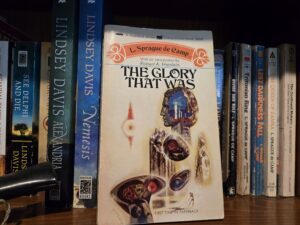
My edition of The Glory That Was is dedicated to Isaac Asimov and boasts an introduction by Robert A. Heinlein. So right up front you have substantial implied attestations of quality. But I’ve learned not to set my sights too high, and tempered my expectations accordingly. I expected an L. Sprague de Camp short novel: smart, droll, erudite, and entertaining, but not grand, emotionally moving, or offering any particularly deep profundity. And that, I’m happy to report, is what I got.
Going in, my expectation was a sort of companion piece to Lest Darkness Fall. After all, the book begins with our hero, Knut Bulnes, and his cowardly, hapless companion ( though, luckily, a classical Greek scholar) Wiyem Flin, pass through a forcefield surrounding the Peloponnese peninsula in pursuit of Flin’s kidnapped wife and find themselves in what appears to be Periclean Athens. But this abrupt change of scenery is about as far as the similarities extend. While the ��hero of Darkness has indeed traveled back in time, the question is soon raised whether or not our 27th Century protagonist has time-traveled or has merely found himself in a sort of elaborate period recreation.
The 27th Century, it seems, is a sort of Constitutional Empire, with a parliament in New York, and a titular, though largely powerless, emperor. This particular emperor, deems himself the embodiment of such notables as Pericles, Henry the IVth, and FDR. And he’s gone missing. So, while Flin hopes desperately that he has in fact somehow gone back through millennia, Bulnes has his doubts. The two encounter the famous names of the period. Through Socrates, they meet the astronomer Meton and are thus able to take more or less accurate star readings to determine the actual date. At this point the story begins to gradually take on more science-fiction trappings as the two work out what has happened, how, and why while the action and tension mount.
Meanwhile, de Camp is displaying the depth of his knowledge of the history, characters, languages, customs, and architecture of the period. He has fun with the Socratic dialogue and sophists, goes into some detail regarding the discomforts and difficulties of life in ancient times, dispelling some of the romance. In fact, as the book continues, the title comes to bear an increasingly sarcastic meaning.
At 156 pages, it is a short read, but just as long as it needs to be. Rather than a companion piece to Darkness, I found it more similar to Divide and Rule and The Stolen Dormouse, two short de Camp novels that demonstrate the breadth of his imagination, his ability to invent novel settings and social/governmental structures. He wasn’t a writer tied to genre conventions. To sum up, good stuff; I liked it. And give yourself a moment to ponder the ending.
Once you’ve read it yourself, you might find yourself short of reading material again. How about something of mine?
August 31, 2025
John Maddox Roberts “S.P.Q.R.” Ave!
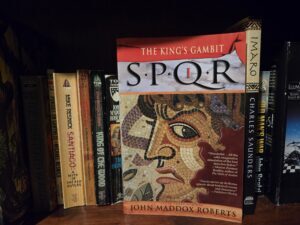
I missed a great deal of excellent adventure fiction by failing to stumble across John Maddox Roberts during the last quarter of the twentieth century. I don’t know why our writing/reading paths did not cross: I was reading this stuff during the same period he was writing it, and it his output was precisely in my wheelhouse.
I’ve picked up the first couple volumes of his S.P.Q.R. series. I’ve completed the first and am about a quarter of the way through the second. I’d have gotten further, but yesterday I took MBW and the HA a mile north to Fredericksburg, TX, toured a portion of the Admiral Nimitz complex of museums, had lunch at a brewpub, then returned home in time to watch college football. So, I was busy.


Anyway, S.P.Q.R. follows the sleuthing adventures of Decius Caecilius Metellus the Younger, told in classic, first-person detective-fiction narration. Please note that I devoured every one of Lindsey Davis’ Falco novels. Falco is a private investigator (or “informer”) working in the later third of the first century AD, in the time of the Flavian dynasty. And I have read one of Steven Saylor’s Sub Rosa novels, and liked that as well. So a series set during the declining years of the Republic (like Sub Rosa), was bound to grab me.

And it did. The first book was terrific. Roberts includes many of the big names of the period as characters/suspects/plot devices, including Julius Caesar, Pompey the Great, Cicero, and Crassus. Unlike the lower class Falco (who only with great reluctance eventually reaches Equestrian rank) Decius is highborn, just beginning his climb the ladder of offices. Though a junior official, he still rubs elbows with the great, and provides the reader with a somewhat different point of view. Both Decius and Falco are still cut from the same cloth, however; the fabric woven by American detective story writers during the first half of the last century.
Roberts seamlessly works in period coloration, from minutiae about gladiatorial weapons and armor, to clothing, to toilets, and so on, easing the reader comfortably into the quotidian details of life in Rome. The mystery is satisfying enough. Roberts allows the reader to figure out the identity of an essential character before the narrator does — and thus feel smug — while Decius pieces together the broader conspiracy. A conspiracy which, in the tradition of noir detective fiction, he can do nothing about.
Good stuff. I’m sure I’ll pick up the rest of the books in due course. I’m going to need more shelves.
And it doesn’t help my shelf space that I keep getting novels published. (Poor me, I know.) I got the final proofs in yesterday from Cirsova for Cesar the Bravo (a solid, chunky 350 pages.)��That should be available for purchase sometime in early or mid-November. It also appears another publisher has accepted a three-book series of mine (currently going by the title Twilight Galaxy.) I will have more information about that later, but it is early days still. If you’d like to read something of mine in the meantime, I would suggest picking up the economically priced, four-book Semi-Autos and Sorcery series. The collection is available in digital and audio. Or you can pick up the print editions separately.
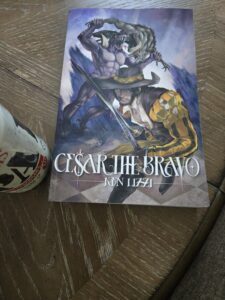
August 24, 2025
Lud-in-the-Mist
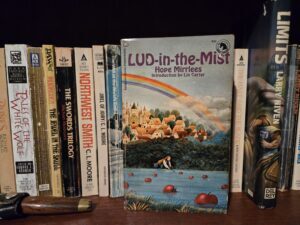
Lin Carter did readers a favor with his Adult Fantasy Series. It is unlikely I would have encountered Hope Mirrlees Lud-in-the-Mist without Ballantine’s unicorn head colophon.
Lud-in-the-Mist belongs to that select group of tales set on the bounds of faerie, along with Lord Dunsany’s The King of Elfland’s Daughter and Tolkien’s Smith of Wooton Major. In this genre of stories, the common lands that we know abut a forbidden — and thus enticing — realm of mystery; the home of elf, fairy, or perhaps even the dead. It is an enchanted place, full of promised wonder. And yet at the same time perilous. Passage from our world to the other is fraught with danger, or at least so holds prevailing folk wisdom.
Hope Mirrlees, despite the twee and charming depictions of her gorgeous prose, leans into the peril. Much as Tolkien did later in Smith, beneath the glamor and compelling temptations there lurks significant darkness. The faerie across the Elfin Hills bordering Dorimare is initially presented in the novel as a sort of whimsical place, the origin of mind-expanding fruits, of music and dance, and the source of unique colloquial expressions. But soon she adds the notion that the country people conflate fairies with the dead.
And when children begin consuming smuggled fairy fruit and head, dancing without cease, the fifty miles to the border, matters take a darker turn. Secrets are revealed. Old murders are revealed. Hangings — both judicial and self-imposed — occur. A complete societal upheaval follows.
The novel largely follows the wonderfully named Nathaniel Chanticleer, Mayor of Lud-in-the-Mist, the capitol of Dorimare, in his personal development. Originally portrayed as a rather vacant, amiable, respectable dullard, his underlying capacity for wonder expands. Driven largely by his realization of paternal love for his son (and his expulsion for office) he takes on the role of hero, doggedly pursuing his son when — late in the book — the lad crosses the border into fairy land. Revelations concerning faerie are few, and a reader who expects a sight seeing trip through the world of elves and sprites will disappointed. But the book is not about faerie, rather it is about the effect of living next to it, while deliberately attempting to collectively turn the back to it.
Mirrlees delves into concepts one might not expect in such a novel. The arbitrary, artificial nature of law. The necessity of art and poetry to balance a prosaic culture. She even appears to note a connection between art and mind altering chemistry (or magic.) And she offers no consolation: even with an admixture of childlike whimsy infused into a well-adjusted, rational mind such as Chanticleer’s: “Nor, I fear, did he cease to be the prey of melancholy. I doubt whether initiation ever brings happiness. It may be that the final secret revealed is a very bitter one…” For all the embroidered, fairy tale style of the prose, Mirrlees deftly ensures that a certain, grim fatalism remains lurking beneath the surface.
Lud-in-the-Mist is a slow, leisurely read, a nice change of pace from more action-oriented fare. If you are in the mood for it, settle in with a cup of tea (laced with something a bit stronger) and enjoy.
And after that, if you want something faster paced, pick up one of my Semi-Autos and Sorcery novels. You can start with Blood and Jade, though there’s no necessity to read them in order.
August 17, 2025
The Web Log is Off Today
Taking a break. Not because I am tired, but because I have too much going on today to take the time to do more than type this brief note.
The web log will return next week.
August 10, 2025
Currently Reading
A short post today, I’m afraid. (Hey, stop that cheering.) I’m freshly returned from Urgent Care this morning for “Paronychia of finger of left hand.” That is, draining an infected thumb. It required three tries for the needle to hit the proper pocket of puss. It was every bit as painful as you are imagining. The point is, even typing hurts so I’ll keep this brief.
I’m reading Hope Mirlees’ Lud-in-the-Mist, the Lin Carter Adult Fantasy Series edition. I am about a third of the way through and finding it charming. I have no idea exactly where the narrative is going and that is a rare treat. I would be reading it now but for the fact that another book showed up a the library. Library books, given their transient nature, take priority.
So, now I’m reading Ian Esslemont’s Forge of the High Mage. This is the fourth book in Esslemont’s series filling in some of the back story to Steven Erikson’s Malazan Book of the Fallen series. There is a sense of anticipation that accompanies a new Malazan book, like walking into a pub you used to frequent: there is a simultaneous sense of familiarity and novelty. The problem with reading these books is the gap of time between publication. Given the cast of thousands, the dozen or so races, the mysteries, etc., I sometimes struggle to recall who is who, and what happened before (or, given the temporal position of this series) what will happen. But it generally comes back to me, at least enough to allow me to muddle through without too much confusion. This one, about a quarter of the way in, appears to follow the standard convergence narrative, with a few disparate groups with conflicting motives, slowly heading toward the same location, all while Esslemont gradually reveals the central mystery. So far, so good.
And in the car and at the gym, I am listening to Agatha Christie’s Hallowe’en Party. It is later Christie, and I find her social commentary interesting. Still don’t know whodunnit. Poirot hasn’t yet identified any prime suspects. But I’m always happy to tag along.
So, that’s it. I’m going to rest for a while. But first, please consider buying one of my books. How about the Semi-Autos and Sorcery series?
August 3, 2025
Jack Williamson’s “Darker Than You Think.” Indeed.

Darker Than You Think does live up to the title in a slow burn fashion. It follows the dawning realization of the protagonist — Will Barbee, hardbitten, alcoholic journalist — that dark forces, witchcraft, and horrific legends of the past are all based on a semi-human race of beings. And that he might in fact be one of them. This is, fundamentally, a horror novel. While some of the horror does come from witchcraft, lycanthropy, and monster attacks, most of it is psychological as Barbee fights against revelations of his own nature. He clings desperately to his humanity even as he commits horrific acts against his oldest friends. It is sharply written stuff. The characters are well-drawn, fitting neatly into that 1940s vein: hard-drinking, chain-smoking, and fast-talking. Jack Williamson wraps it all in the language of then cutting edge science: quantum probability, molecular mutability, ESP, etc., though it probably would have worked just as well as straight horror without the sci-fi trappings.
The darkness hinted at in the title comes from the readers viewpoint: it isn’t merely Will Barbee’s humanity at stake during his struggle, it is ultimately mankind’s existence. So, yes, as the end nears, it is indeed darker than you think.
Originally a novelette published in 1940 by Unknown, Jack Williamson extended Darker to novel length for post-war publication. I’d like to read the original sometime because one of my few criticisms is that the reader grasps the premise rather quickly. Much of the rest could have felt like filler in the hands of a lesser writer. The entire story covers only a few days. There is a hint of rinse-and-repeat about Barbee’s shape-changing “dreams”, his waking to discount the events of the night as mere dreams in spite of all evidence, then reiterating the whole thing again with a slight variation that at least does move the story along. One could imagine a reader thinking “get on with it already.” But the little details Williamson provides, filling in the back story, keep the reader interested even after having comprehended the larger picture a couple of chapters in and knowing more or less how the story is going to end, including the identity of the Child of Night. It shouldn’t work for 200+ pages, but it does. That is a testimony to Williamson’s chops. Kudos to him. Worth the read.
I hope those who backed Cesar the Bravo will consider that worth the read. Thanks to all those who backed it. And for those who missed it, don’t worry; it will be on sale sometime in December, or so I am led to believe.



